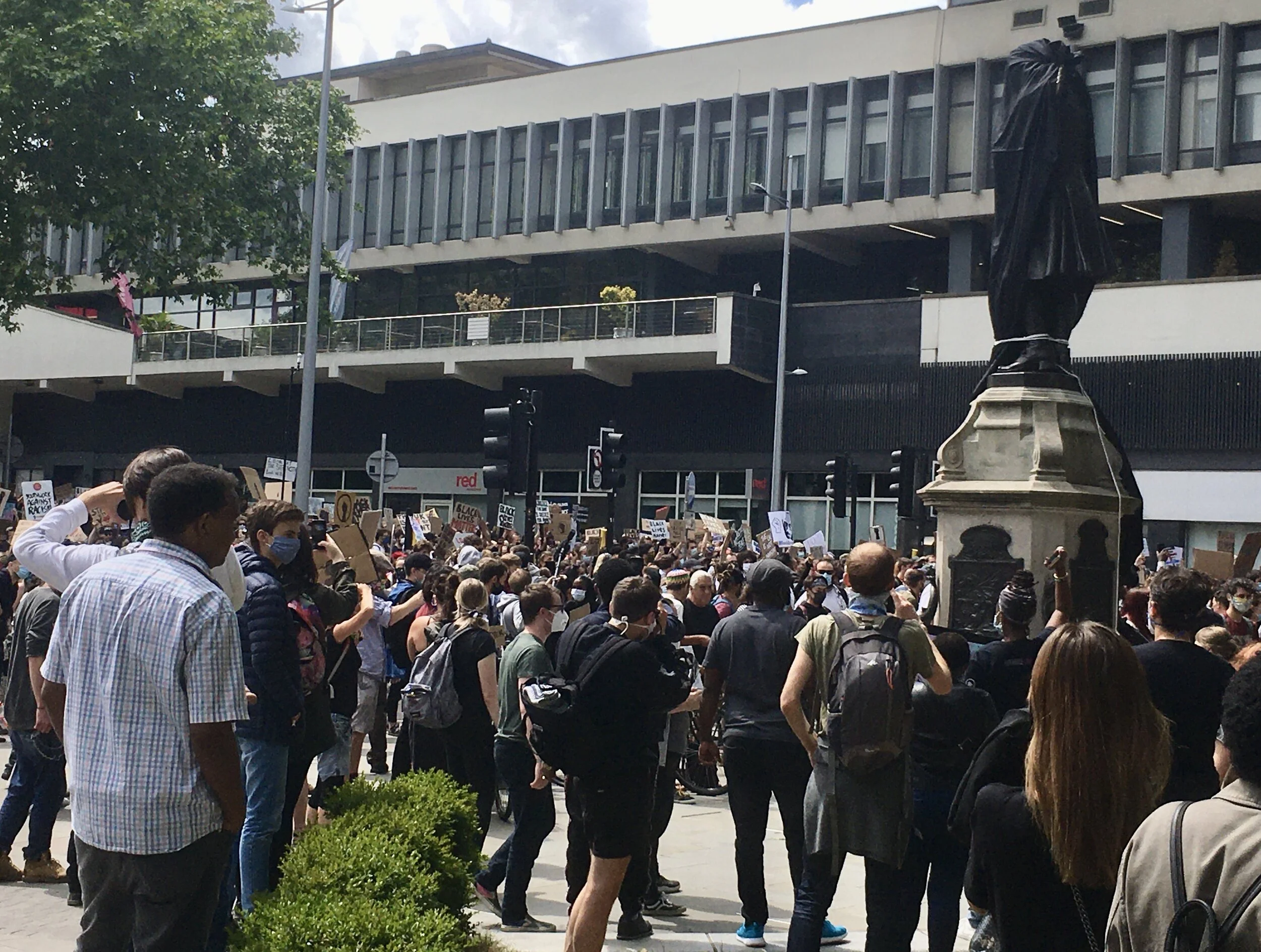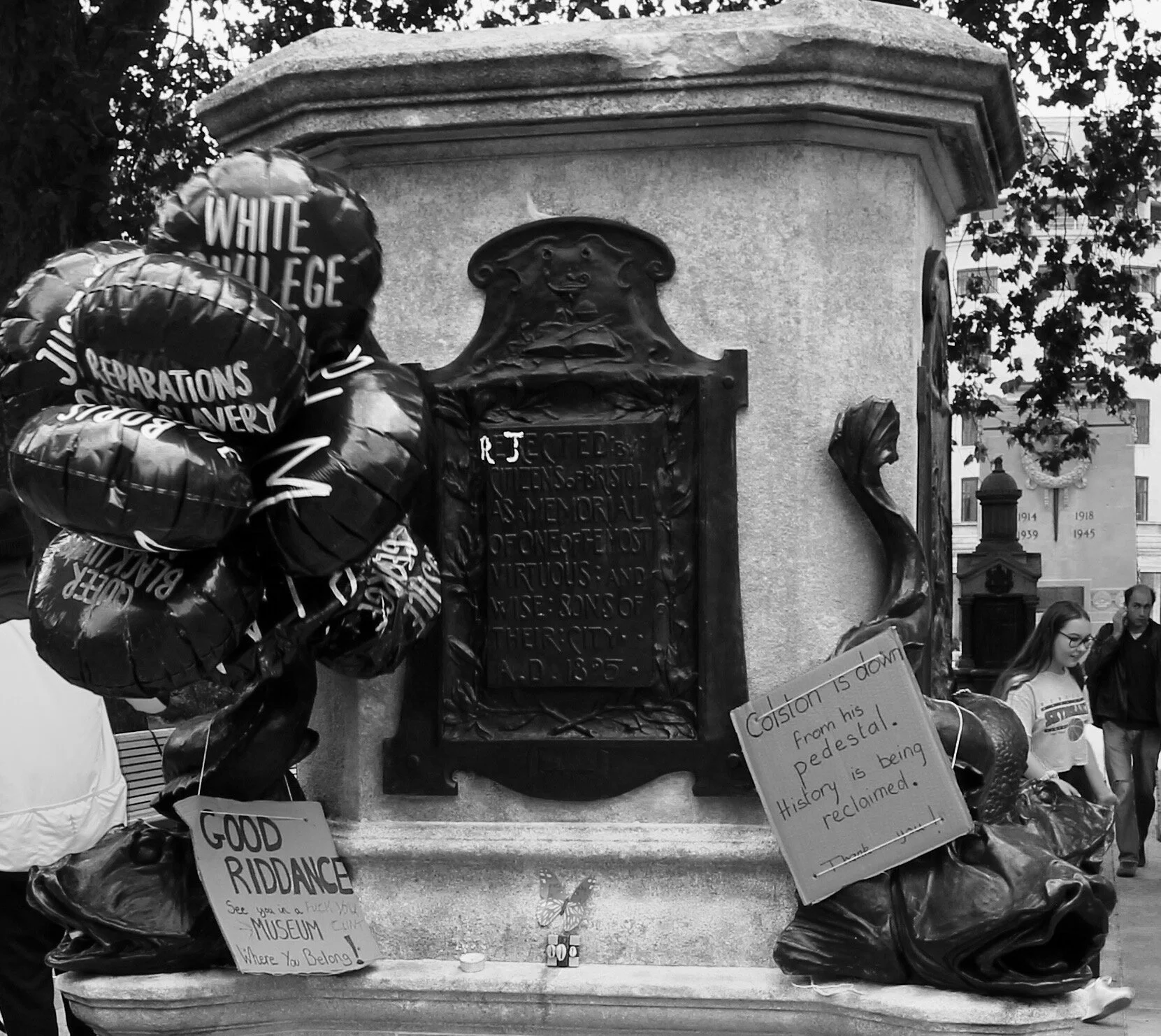The Fall of Edward Colston as The Fall of Imperialism’s Adoration
It was a warm day of late spring the past Sunday. Thousands were united in College Green under a bright sun. The voice of activists was filling in the square with emotional speeches, followed by tireless clapping from the crowd in the background. The chant of “Black Lives Matter” accompanied the march. Everyone with masks on their faces, big placards hailed up in the air. Entering Colston Avenue the number of people increased. Passing by, cars were beeping as a sign of approval. The statue of Edward Colston was there, shining on his pedestal for the last time, with a black drape on his face. It had not been too long when some protesters pulled the bronze figure down. With excitement, they dragged it all the way until they reached Pero’s Bridge, named after John Pinney’s slave, to throw it in the harbour. In that harbour where, once, his ships used to dock. Here, at the bottom of the river, the figure of Edward Colston lied for 4 glorious days, until being rescued in the early hours of Thursday 11th.
The statue was erected in 1895, during an era, the late-Victorian period, that saw the tendency of commemorating figures who embedded certain values. This, in part, represents what the historian Eric Hobsbawm named “invention of tradition”. Colston was a Bristol born merchant, who helped with his wealth the development of the city. A philanthropist, a son of Bristol, who was thought to deserve to be remembered. Unfortunately, in this act of adoration, it had been “forgotten” that his vast fortune came from the trade of thousands of African slaves. His sculpture has been subject of discussion for decades. An online petition asking for its removal, that was launched three years ago, reached 10,000 signatures in the last 10 days. The fall of Edward Colston was the result of too many unheard voices, who decided to make social justice for themselves. Probably, many have learned more about Colston’s legacy from his tumble rather than his plinth.
Pictures, videos and footage of the act became soon viral. The public opinion divided. Lots were the comments in favour, suggesting that the statue should have never been there for so long in the first place, that a museum is a more suitable site for it. A petition for replacing Colston with a figure remembering the victims of slave trades has already been launched. Also, local artists, like Banksy, are expressing ideas about what could be put in place. On the other side, the sentiment is that vandalism should not be condoned, that erasing history is not the solution to fight racial discrimination. “Utterly disgraceful” were the words used by Home Secretary Priti Patel for describing the fact. A more moderate opinion came from Bristol’s mayor, Marvin Rees, that even if he does not excuse violence, he thinks it is important to listen to those who found the statue as an affront to their community.
This powerful gesture awoke the consciousnesses of Britain over the dark part of its history. All labour councils across England and Wales are now working on reviewing their statues and public monuments linked to slavery. In London, the mayor Sadiq Khan has formed a new Commission for Diversity in the Public Realm that will examine all the capital’s landmarks (street names, public building names and plaques), which legacies should be commemorate as well as explore suggestions of new figures to use instead. In Bristol, Marvin Rees confirmed that a commission formed by historians and city planners will work on researching and highlighting the diverse history of the city. Also, Colston Hall, Bristol’s biggest concert hall, has committed to change name at its reopening expected for the coming autumn. Manchester’s council announced to start moving on the same path. From Cardiff, it came the support of its leader for removing the image of slave-owner Thomas Picton from the civic building.
The new challenge will be to carefully evaluate which icons of our past to maintain and which ones to add. History was often cruel and oppressive. Rome is full of monuments that remind of Ancient Romans violence, the Colosseum is just one example. It is called historical relativism: contextualising past events according to their times and societies. History cannot be lost. It helps to understand the present. It has to be studied, analysed, understood: all of it though. Our cities should commemorate the memory of each community that had been part of it. In a globalised world, studying the historical development of every population would be advantageous for preventing conflicts and tackling the problem of racism from its core. The initiatives of reviewing controversial figures from public spaces are an important step. However, it is just the beginning towards a more inclusive society. It would not be enough the downfall of some busts for addressing racial inequality.
Yet, an issue, that had not been taken much into consideration during the previous years, is finally among cities’ priorities. The debate has been opened and we are all looking forward to some results. First reactions appear not to be just empty words and fake promises. On the 9th of June the statue of the merchant and slaveholder Robert Milligan has already been removed from West India Docks. It has not yet been the case of Oxford, where the movement known as Rhodes Must Fall began in 2015 is increasing its pressure over the city council. After Bristol’s protest, one thousand of demonstrators gathered in Oxford for peacefully asking to remove the image of the imperialist Cecil Rhodes, still standing in front of the prestigious University. It is now matter of time to see if city’s leaders will embrace citizen’s discomfort or if the next BLM protest, scheduled for the upcoming Saturday, will end up with its overthrow.
The epic fall of Edward Colston is not affecting just the UK. As the murder of George Floyd initiated a wave of activism across the world, the iconoclast fight against symbols of imperialism and slavery is spreading at the same pace. In Belgium, a statue representing King Leopold II has been removed after being vandalised and set on fire. In Milan, the debate has been rekindled about the removal of Indro Montanelli’s sculpture, the Italian journalist who declared to have bought and married a 12 years old Eritrean girl during the Abyssinian War of 1936. Throughout the ongoing BLM protests in the US, many Confederate monuments became a target. In Virginia, the statue of Christopher Columbus saw a similar epilogue of Bristol’s one: toppled down, set on fire and thrown into a lake. In other Southern countries, controversial figures have been vandalised by rioters. During Richmond’s demonstration, the building of The United Daughters of the Confederacy burnt.
"The building is a symbol, as is the act of destroying it. Symbols are given power by people. Alone a symbol is meaningless, but with enough people, blowing up a building can change the world” said V, the freedom fighter of V for Vendetta. This is the message. A statue in the middle of a square is not just history, it is a symbol. Memento of adoration, of a past that has not been always fair. There, in front of our eyes every time we walk by. A statue that represents oppression, a big scar for the black community. Trowing it down is not just vandalism, it is a symbol. The pursuit of a better society, a desperate scream to say that all this is enough. The last 7th of June was a day where thousand of people were there, together, to affirm, loudly, that Black Lives Matter, that racism must not be an option, that too many inequalities still occurred. Well, the dive of Edward Colston, the slave trader, was eventually the most powerful way for conveying these feelings, for expressing the Message.
Written by Chiara Castro
Chiara is an Italian writer based in Bristol. She likes writing about things that matter and stuff she loves. Travels, books, movies and good beers are some of them. Check her out here https://medium.com/@chiaracastro
References:
“invention of tradition”: https://www.cambridge.org/core/books/invention-of-tradition/introduction-inventing-traditions/05B9EDFC0304BE3F5D704BB66B286710
“Utterly disgraceful”: https://www.politicshome.com/news/article/boris-johnson-claims-black-lives-matters-protests-subverted-by-thuggery-as-tories-hit-out-at-removal-of-slave-trader-statue
Commission for Diversity in the Public Realm: https://www.theguardian.com/world/2020/jun/09/sadiq-khan-orders-review-of-all-london-statues-for-slavery-links
Rhodes Must Fall: https://en.wikipedia.org/wiki/Rhodes_Must_Fall
The United Daughters of the Confederacy: https://en.wikipedia.org/wiki/United_Daughters_of_the_Confederacy



